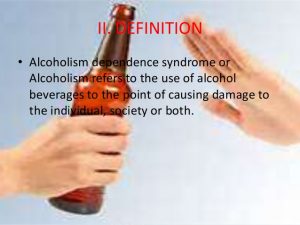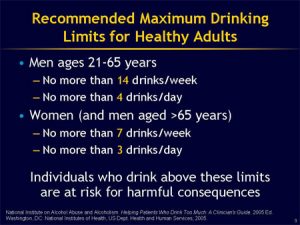
Question:
Explain the epidemiology of Alcoholism. Critically discuss the public policy options which are available to address this problem.
Introduction
According to Alcohol Concern Organisation (2015) more than 9 million people in England consume alcoholic beverages more than the recommended daily limits. In relation to this, the National Health Service (2015) actually recommends no more than 3 to 4 units of alcohol a day for men and 2 to 3 units a day for women. The large number of people consuming alcohol more than the recommended limits, highlights the reality that alcoholism is a major health concern in the UK which can lead to a multitude of serious health problems. Moss (2013) states that alcoholism and chronic use of alcohol are linked to various medical, psychiatric, social and family problems. To add to this, the Health and Social Care Information Centre (2014) reported that between 2012 and 2013, a total of 1,008,850 admissions related to alcohol consumption where an alcohol-related disease, injury or condition was the primary cause for hospital admission or a secondary diagnosis. This shows the detrimental impact of alcoholism on the health and overall wellbeing of millions of people in the UK. It is therefore vital to examine the aetiology of alcoholism in order to understand why so many people end up consuming excessive alcohol. The National Institute on Alcohol Abuse and Alcoholism (NIAAA) (n.d.) supports this by stating that learning the natural history of a disorder will provide information essential for assessment and intervention and for the development of effective preventive measures. This essay will also look into the different public health policies that address the problem of alcoholism in the UK. A brief description of what alcoholism is will first be provided.
What is Alcoholism?

Alcohol dependence is worse because according to the National Institute for Health and Care Excellence (2011, n.p.) it “indicates craving, tolerance, a preoccupation with alcohol and continued drinking regardless of harmful consequences” (e.g. liver disease). Under the Diagnostic Statistical Manual of Mental Disorders (DSM)- 5, these two have been joined as one disorder called alcohol use disorder or AUD with mild, moderate and severe sub-classifications (NIAAA 2015).
Genetic Aetiologic Factor of Alcoholism
Alcoholism is a complex disorder with several factors leading to its development (NIAAA 2005). Genetics and other biological aspects can be considered as one factor involved in the development of alcohol abuse and dependence (NIAAA 2005). Other factors include cognitive, behavioural, temperament, psychological and sociocultural (NIAAA 2005).
According to Goodwin (1985) as far as the era of Aristotle and the Bible, alcoholism was believed to run in the families and thus could be inherited. To some extent, there is some basis that supports this ancient belief because in reality, alcoholic parents have about four to five times higher probability of having alcoholic children (Goodwin 1985). Today, this belief seems to lack substantially clear and direct research-based evidence. On the other hand, studies also do not deny the role of genetics in alcoholism. With this view, it is therefore safe to argue that genetics is considered still as an important aetiologic factor in alcoholism.
The current consensus simply indicates that there is more to a simple gene or two that triggers the predisposition of an individual to become an alcoholic. Scutti (2014) reports that although scientists have known for some time that genetics take an active role in alcoholism, they also propose that an individual’s inclination to be dependent on alcohol is more complicated than the simple presence or absence of any one gene. The National Institute on Alcohol Abuse and Alcoholism (2008) states that there is no one single gene that fully controls a person’s predisposition to alcoholism rather multiple genes play different roles in a person’s susceptibility in becoming an alcoholic. The NIAAA (2005) further claims that the evidence for a genetic factor in alcoholism lies mainly with studies that involve extended pedigree, those that involve identical and fraternal twins and those that include adopted individuals raised apart from their alcoholic parents.
For pedigree studies, it is believed that the risk of suffering from alcoholism is increased four to seven fold among first-degree relatives of an alcoholic (Cotton 1979; Merikangas 1990 cited in NIAAA, 2005.). First degree relatives naturally refer to parent-child relationships; hence, a child is therefore four to seven times at higher risk of becoming an alcoholic, if one or both of their parents are alcoholics. Moss (2013) supports this by stating that children whose parents are alcoholic are at higher risk of becoming alcoholics themselves when compared to children whose parents are non-alcoholics.
A study conducted by McGue, Pickens and Svikis (1992 cited in NIAAA 2005) revealed that identical twins generally have a higher concordance rate of alcoholism compared to fraternal twins or non-twin siblings. This basically means that a person who has an alcoholic identical twin, will have a higher risk of becoming an alcoholic himself when compared to if his alcoholic twin is merely a fraternal twin or a non-twin sibling. This study further proves the role of genetics in alcoholism because identical twins are genetically the same; hence, if one is alcoholic, the other must therefore also carry the alcoholic gene.
The genetic factor in alcoholism is further bolstered by studies conducted by Cloninger, Bohman and Sigvardsson 1981 cited in NIAAA 2005 and Cadoret, Cain and Grove (1980 cited in NIAAA 2005) involving adopted children wherein the aim was to separate the genetic factor from the environmental factor of alcoholism. In these studies, children of alcoholic parents were adopted and raised away from their alcoholic parents but despite this, some of these children still develop alcoholism as adults at a higher rate than those adopted children who did not have an alcoholic biological parent (Cloninger et al., 1981 cited in NIAAA 2005 and Cadoret et al., 1980 cited in NIAAA 2005).
One interesting fact about aetiologic genetic factor is that although there are genes that indeed increase the risk of alcoholism, there are also genes that protect an individual from becoming an alcoholic (NIAAA 2008). For example, some people of Asian ancestry carry a gene that modifies their rate of alcohol metabolism which causes them to manifest symptoms such as flushing, nausea and tachycardia and these generally lead them to avoid alcohol; thus, it can be said that this gene actually helps protect those who possess it from becoming alcoholic (NIAAA 2008).
Environment as an Aetiologic Factor of Alcoholism
Another clearly identifiable factor is environment, which involves the way an individual is raised and his or her exposure to different kinds of activities and opportunities. The National Institute on Alcohol Abuse and Alcoholism (2005) relates that the genetic factor and the environmental factor have a close relationship in triggering alcoholism in an individual. This can be explained by the simple fact that even if an individual is genetically predisposed to becoming an alcoholic, if he is not exposed to a particular kind of environment which triggers activities that lead to alcohol intake, the likelihood of his becoming an alcoholic will be remote.
There are certain aspects within the environment that makes it an important aetiologic factor. According to Alcohol Policy MD (2005) these aspects include acceptance by society, availability and public policies and enforcement.
Acceptance in this case refers to the idea that drinking alcoholic drinks even those that should be deemed excessive is somewhat encouraged through mass media, peer attitudes and behaviours, role models, and the overall view of society. Television series, films and music videos glorify drinking sprees and even drunken behaviour (Alcohol Policy MD 2005). TV and film actors and sports figures, peers and local role models also encourage a positive attitude towards alcohol consumption which overshadows the reality of what alcohol drinking can lead to (Alcohol Policy MD 2005). In relation to this, a review of different studies conducted by Grube (2004) revealed that mass media in the form of television shows for instance has an immense influence on the youth (age 11 to 18) when it comes to alcohol consumption. In films, portrayals regarding the negative impact of alcohol drinking are rare and often highlight the idea that alcohol drinking has no negative impact on a person’s overall wellbeing (Grube 2004). In support of these findings, a systematic review of longitudinal studies conducted by Anderson et al. (2009) revealed that the constant alcohol advertising in mass media can lead adolescents to start drinking or to increase their consumption for those who are already into it.
Availability of alcoholic drinks is another important environmental aetiologic factor of alcoholism simply because of the reality that no matter how predisposed an individual is to become an alcoholic, the risk for alcoholism will still be low if alcoholic drinks are not available. On the other hand, if alcoholic beverages are readily available as often are today, then the risk for alcoholism is increased not only for those who are genetically predisposed to alcoholism but even for those who do not carry the “alcoholic genes”. The more licensed liquor stores in an area, the more likely people are to drink (Alcohol Policy MD 2005). The cheaper its price, the more affordable it is for people to buy and consume it in excess (Alcohol Policy MD 2005).
Another crucial environmental aetiologic factor is the presence or absence of policies that regulate alcohol consumption and its strict or lax enforcement. It includes restricting alcohol consumption in specified areas, enacting stricter statutes concerning drunk driving and providing for penalties for those who sell to, buy for or serve to underage individuals (Alcohol Policy MD 2005). It is worthy to point out that in the UK, the drinking age is 18 and a person can be stopped, fined or even arrested by police if he or she is below this age and is seen drinking alcohol in public (Government UK 2015a). It is also against the law for someone to sell alcohol to an individual below 18; however, an individual age 16 or 17 when accompanied by an adult can actually drink but not buy alcohol in a pub or drink beer, wine or cider with a meal (Government UK 2015a).
Policies to Combat Alcoholism
One public health policy that can help address the problem on alcoholism is the mandatory code of practice for alcohol retailers which banned irresponsible alcohol promotions and competitions, and obliged retailers to provide free drinking water, compelled them to offer smaller measures and required them to have proof of age protocol. It can be argued that this policy addresses the problem of alcoholism by restricting the acceptance, availability and advertising of alcohol (Royal College of Nursing 2012). Another is the Police Reform and Social Responsibility Act 2011 which is a statute that enables local authorities to take a tougher stance on establishments which break licensing rules about alcohol sale (Royal Collage of Nursing 2012).
There is also the policy paper on harmful drinking which provides different strategies in addressing the problem of alcoholism. One such strategy is the advancement of the Change4Life campaign which promotes healthy lifestyle and therefore emphasises the recommended daily limit of alcohol intake for men and women (Government UK 2015b). Another strategy within this policy is the alcohol risk assessment as part of the NHS health check for adults ages 40 to 75 (Government UK 2015b). This policy aims to prevent rather than cure alcoholism which seems to be logical for after all, an ounce of prevention is better than a pound of cure.
Conclusion
Alcoholism which includes both alcohol misuse and alcohol dependence is a serious health problem which affects millions in the UK. Its aetiology is actually a combination of different factors. One vital factor is genetics wherein it can be argued that some people are predisposed to becoming an alcoholic. For example, an individual is at higher risk of becoming an alcoholic if he or she has a parent who is also alcoholic. When coupled with environmental factors, the risk of suffering from alcoholism becomes even greater. Environment refers to the acceptability and availability of alcohol and the presence or absence of policies that regulate alcohol sale and consumption. Vital health policies such as Harmful Drinking Policy Paper advocated by the government, are important preventive measures in reducing the incidence and prevalence of alcoholism in the UK.
References
Alcohol Concern Organisation (2015). Statistics on alcohol. [online]. Available from: https://www.alcoholconcern.org.uk/help-and-advice/statistics-on-alcohol/ [Accessed on 28 September 2015].
Alcohol Policy MD (2005). The effects of environmental factors on alcohol use and abuse. [online]. Available from: http://www.alcoholpolicymd.com/alcohol_and_health/study_env.htm[Accessed on 28 September 2015].
Anderson, P., de Brujin, A., Angus, K., Gordon, R. and Hastings, G. (2009). Impact of alcohol advertising and media exposure on adolescent alcohol use: A systematic review of longitudinal studies. Alcohol and Alcoholism. 44(3):229-243.
Goodwin, D. (1985). Alcoholism and genetics: The sins of the fathers. JAMA Psychiatry. 42(2):171-174.
Government UK (2015a). Alcohol and young people. [online]. Available from: https://www.gov.uk/alcohol-young-people-law [Accessed on 28 September 2015].
Government UK (2015b). policy paper 2010 to 2015 government policy: Harmful drinking. [online]. Available from: https://www.gov.uk/government/publications/2010-to-2015-government-policy-harmful-drinking/2010-to-2015-government-policy-harmful-drinking [Accessed on 28 September 2015].
Grube, J. (2004). Alcohol in the media: Drinking portrayals, alcohol advertising, and alcohol consumption among youth. [online]. Available from:http://www.ncbi.nlm.nih.gov/books/NBK37586/ [Accessed on 28 September 2015].
Health and Social Care Information Centre (2014). Statistics on alcohol England, 2014. [online]. Available from: http://www.hscic.gov.uk/catalogue/PUB14184/alc-eng-2014-rep.pdf [Accessed on 28 September 2015].
Moss, H.B. (2013). The impact of alcohol on society: A brief overview. Social Work in Public Health. 28(3-4):175-177.
National Health Service (2015). Alcohol units. [online]. Available from: http://www.nhs.uk/Livewell/alcohol/Pages/alcohol-units.aspx [Accessed on 28 September 2015].
National Health Services Choices (2013). Alcohol misuse. [online]. Available from: http://www.nhs.uk/conditions/alcohol-misuse/pages/introduction.aspx [Accessed on 28 September 2015].
National Institute on Alcohol Abuse and Alcoholism (2015). Alcohol use disorder: A comparison between DSM-IV and DSM-5. [online]. Available from: http://pubs.niaaa.nih.gov/publications/dsmfactsheet/dsmfact.pdf [Accessed on 28 September 2015].
National Institute on Alcohol Abuse and Alcoholism (2008). Genetics of alcohol use disorder. [online]. Available from: http://www.niaaa.nih.gov/alcohol-health/overview-alcohol-consumption/alcohol-use-disorders/genetics-alcohol-use-disorders [Accessed on 28 September 2015].
National Institute on Alcohol Abuse and Alcoholism (2005). Module 2: Etiology and natural history of alcoholism. [online]. Available from: http://pubs.niaaa.nih.gov/publications/Social/Module2Etiology&NaturalHistory/Module2.html [Accessed on 28 September 2015].
National Institute for Health and Care Excellence (2011). Alcohol-use disorders: Diagnosis, assessment and management of harmful drinking and alcohol dependence. [online]. Available from: https://www.nice.org.uk/guidance/CG115/chapter/Introduction [Accessed on 28 September 2015].
Royal College of Nursing (2012). Alcohol: policies to reduce alcohol-related harm in England. [online]. Available from: https://www.rcn.org.uk/__data/assets/pdf_file/0005/438368/05.12_Alcohol_Short_Briefing_Feb2012.pdf [Accessed on 28 September 2015.
Scutti, S. (2014). Is alcoholism genetic? Scientists discover link to a network of genes in the brain. [online]. Available from: http://www.medicaldaily.com/alcoholism-genetic-scientists-discover-link-network-genes-brain-312668 [Accessed on 28 September 2015].


You must be logged in to post a comment.